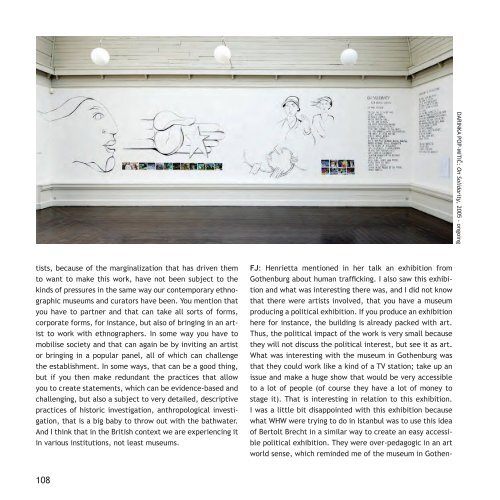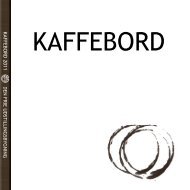læs bogen her - Den Frie
læs bogen her - Den Frie
læs bogen her - Den Frie
Create successful ePaper yourself
Turn your PDF publications into a flip-book with our unique Google optimized e-Paper software.
tists, because of the marginalization that has driven them<br />
to want to make this work, have not been subject to the<br />
kinds of pressures in the same way our contemporary ethnographic<br />
museums and curators have been. You mention that<br />
you have to partner and that can take all sorts of forms,<br />
corporate forms, for instance, but also of bringing in an artist<br />
to work with ethnograp<strong>her</strong>s. In some way you have to<br />
mobilise society and that can again be by inviting an artist<br />
or bringing in a popular panel, all of which can challenge<br />
the establishment. In some ways, that can be a good thing,<br />
but if you then make redundant the practices that allow<br />
you to create statements, which can be evidence-based and<br />
challenging, but also a subject to very detailed, descriptive<br />
practices of historic investigation, anthropological investigation,<br />
that is a big baby to throw out with the bathwater.<br />
And I think that in the British context we are experiencing it<br />
in various institutions, not least museums.<br />
108<br />
FJ: Henrietta mentioned in <strong>her</strong> talk an exhibition from<br />
Gothenburg about human trafficking. I also saw this exhibition<br />
and what was interesting t<strong>her</strong>e was, and I did not know<br />
that t<strong>her</strong>e were artists involved, that you have a museum<br />
producing a political exhibition. If you produce an exhibition<br />
<strong>her</strong>e for instance, the building is already packed with art.<br />
Thus, the political impact of the work is very small because<br />
they will not discuss the political interest, but see it as art.<br />
What was interesting with the museum in Gothenburg was<br />
that they could work like a kind of a TV station; take up an<br />
issue and make a huge show that would be very accessible<br />
to a lot of people (of course they have a lot of money to<br />
stage it). That is interesting in relation to this exhibition.<br />
I was a little bit disappointed with this exhibition because<br />
what WHW were trying to do in Istanbul was to use this idea<br />
of Bertolt Brecht in a similar way to create an easy accessible<br />
political exhibition. They were over-pedagogic in an art<br />
world sense, which reminded me of the museum in Gothen-<br />
DARINKA POP-MITIČ: On Solidarity, 2005 - ongoing



